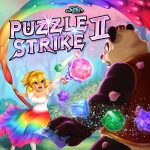
The higher your gem pile, the more powerful you become—but if they get too high, you’ll be overwhelmed!
What Is Puzzle Strike 2?
Puzzle Strike 2 is a deck-building game for 1 to 4 players, ages 13 and up, and takes about 20–30 minutes to play. It’s currently seeking funding on Kickstarter, with a pledge level of $70 for a copy of the game (or $100 to include the expansion). The game is a newly designed sequel to Puzzle Strike, with enough significant changes to the gameplay to make it a wholly different experience.
Puzzle Strike 2 was designed by David Sirlin and published by Sirlin Games.
New to Kickstarter? Check out our crowdfunding primer.

Puzzle Strike 2 Components
Note: My review is based on a prototype copy, so it is subject to change and may not reflect final component quality. The prototype did not include the scepter, and the gems are generic plastic gems rather than the glittery gems with unique shapes that the finished game will include. The boards in the prototype were also a bit oversized and will be smaller in the finished game.
Here’s what comes in the box:
- Bank board
- 8 Player boards (1 vertical and 1 horizontal board per player)
- Scepter of Power
- 120 Gems (30 each purple, pink, blue, green)
- 3 Diamonds
- 20 Gem tokens
- 20 Action tokens
- 198 cards:
- 30 Character cards (3 each for 10 characters)
- 28 Starting deck cards (7 per player)
- 2 Ante Up cards
- 16 Wound cards
- 61 Grand Melee bank cards
- 61 Birthday Bash bank cards
Although the plastic components like the gems and scepters weren’t finished in the prototype, you can get a better look at them on the Kickstarter page. Each gem color has a unique shape (matching the icons on the boards and cards), and are made of a sparkly plastic. The scepter itself is quite large, with a big pink diamond on the top and a clear crystal ball at the bottom, and it lights up! Okay, it’s kind of silly, but I like it—I like the idea of wielding a purple and pink scepter and trying to be Very Serious about the powers it conveys. (That’s assuming my 8-year-old doesn’t run off with it.)
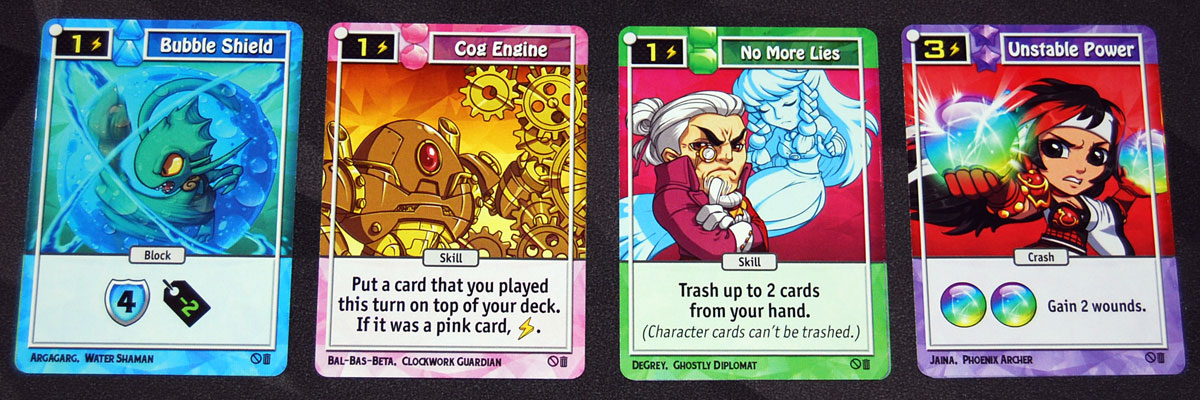
The cards themselves feature illustrations featuring chibi versions of the characters from the Fantasy Strike universe—also seen in games like Yomi and Flash Duel.
Each player has two boards: one tracks their gem pile and power meters, and the other mostly serves as a player aid, with room for a deck and discard pile. This second one you could probably do without once you’re familiar with the game, if you need to conserve space on the table.
How to Play Puzzle Strike 2
You can download a copy of the rulebook here, and you can try it out on Tabletopia.
The Goal
The goal of the game is to survive the longest by crashing gems to prevent your pile from overflowing and sending gems to your opponents.
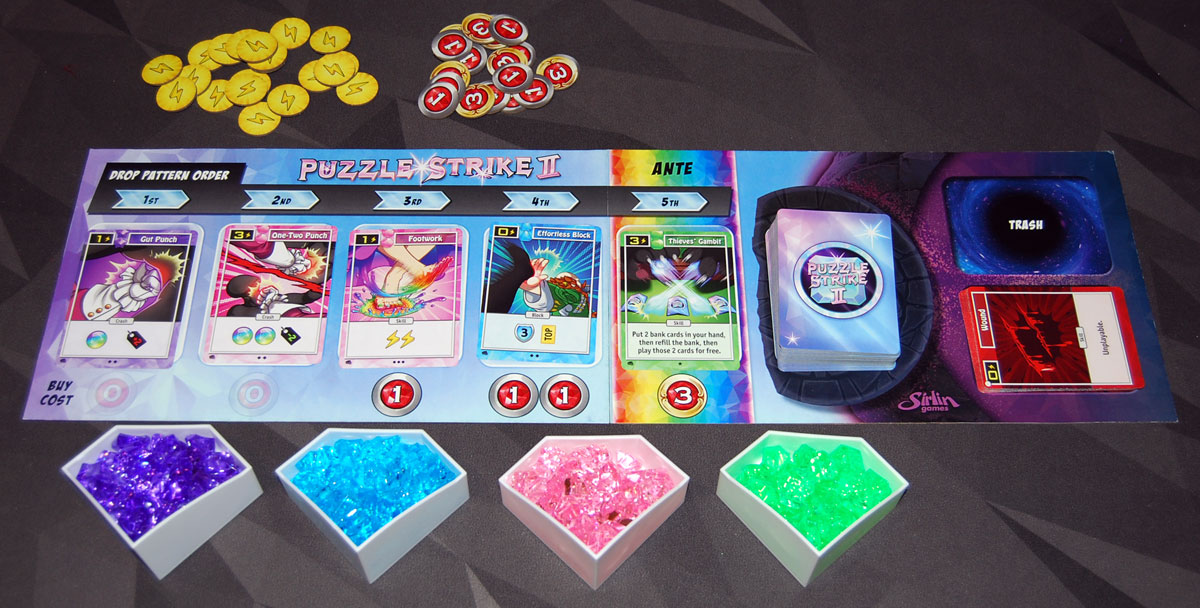
Setup
The bank board goes in the center, along with your chosen bank deck, which will have the two Ante Up cards inserted based on the player count. The Wound cards also go on the bank board. Flip five cards face-up to form the bank.
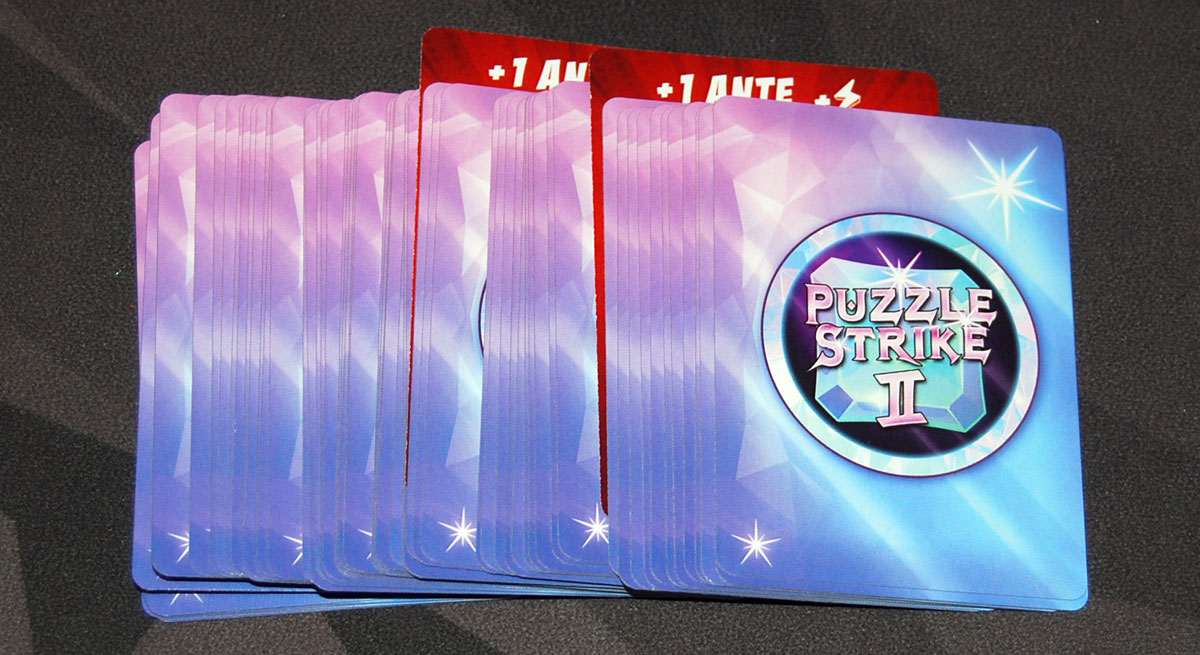
Give each player the two player boards, a starting deck, and the three character cards for their chosen character. Each player puts 2 gem tokens in the “incoming” section of their board. The first player takes the scepter, and all other players take a diamond. Everyone should shuffle their decks and draw 5 cards.
Gameplay
On your turn, you do the following steps: Ante, Actions, Buy, Draw. The scepter player will also make a Command Decision at the end of each non-scepter player’s turn.
Ante: add two gems to your gem pile matching the color of the 5th card in the bank (marked “Ante”).

Actions: This is the part where you get to play cards from your hand. You start with 3 energy, and each card has an energy cost to play. Cards will allow you to swap gems in your gem pile, draw more cards, gain energy, block incoming gems, and crash gems, among other things. Blocking incoming gems simply allows you to remove them from the “incoming” section of your board.
Crashing is the crux of the game: when you crash a gem, typically it removes the top gem of your pile, along with any contiguous group of the same color, and then sends that many gems to your opponent, putting gem tokens into their incoming section. The gems you remove go into your power meters (of the corresponding colors). In addition, there’s a height bonus based on the top gem that was crashed—the higher your pile, the more extra gems you send to your opponent, as long as you crashed at least a pair. Note: if you have the scepter, you send gems to everyone else; everyone else sends gem to the scepter player.

If any of your power meters fills up, you get to trigger their super moves, then clear out the meter. (If you have leftover gems, they go into the meter.)
- Purple: Overload: The opponent antes a blue gem, then a pink gem, then a green gem.
- Blue: Purify: Choose a color and remove all gems of that color from your pile.
- Pink: Energize: Gain 2 energy, draw 2 cards.
- Green: Trickshot: Put a bank card into your hand—you may play it at no cost this turn.
Your incoming section may have tokens indicating how many gems will drop into your pile this turn if you don’t block them. The scepter player always has to drop them immediately after the ante, but other players may choose when during their Action phase they want to drop them, as long as they do it before the Buy phase of their turn. The colors that fall into your pile are based on the bank cards, from left to right (wrapping back around if necessary)—you just add one gem for each token in your incoming.
If you weren’t the starting player, your diamond may be spent one time during the game to trigger any of your four super moves.
Buy: After you’re done with your actions, you must buy one card from the bank and place it into your discard pile. The cost is shown below the cards, and is paid by taking incoming gems.
Discard: Discard all of the cards you’ve played and those left in your hand, and draw 5 more cards from your deck plus whatever your current height bonus is.
If you don’t have the scepter, the scepter player makes a Command Decision: either power up by adding one gem of each color to their power meters, or relinquish the scepter to the player who just ended their turn.
During the game, when the Ante Up cards are revealed in the bank deck, they’re placed next to the Ante section of the board. Now, players will ante an additional gem, but also have an additional energy on their turns.
Game End
The game end is triggered when a player ends their turn with more than 10 gems in their pile. In a 2-player game, the game ends and the other player wins. For more players, this triggers the Grand Finale, in which each player will get one more turn but with slightly different rules. Non-scepter players will get 10 incoming gems and also adds one gem to each of their power meters; they also don’t send gems to the scepter player during the Grand Finale, but instead each gem that would be sent removes 1 incoming gem instead.
Anyone who doesn’t bust on their final turn is a winner. If you want a single winner, it’s the player who has the lowest gem pile plus incoming gems (even if it’s the player who busted in the first place!).
Why You Should Play Puzzle Strike 2
Puzzle Strike is a board game that simulates a puzzle video game that simulates a fighting game—this is true both of the original board game and this new iteration. I’ve always liked the absurdity of the theme, but there’s also some really slick mechanics backing it up. The idea is you’re playing a sort of puzzle game, with gems falling onto your screen that you have to match up and “crash” to get rid of. Meanwhile, making big combos means that you send garbage to your opponents, which they then have to deal with, and the goal is to outlast your opponents.
If you’ve played the original Puzzle Strike game, you’ll notice some pretty big changes in this design, both in appearance and in the gameplay. One change is from chips to cards: although the original was functionally a deck-building game, it did it through cardboard poker chips that you threw into a bag to mix up, and now it’s a more standard card game. Crash gems—the way you send gems from your pile to other players—are familiar, but now instead of “combine” you have “swap,” because of the biggest change: the gems actually have different colors now.
In the original, the gems just had a numerical value but they were all green—it was just a stand-in for the height of your gem pile. You were able to combine gems to create single tokens of a higher value, and each crash gem would crash a single token, breaking it back apart into “1” tokens that went to your opponent. You could combine up to a 4-gem token for maximum effect against your opponents.
Now, the gems have different colors, so there’s an added puzzle element that brings the board game another step closer to simulating the gem puzzle video game: you have to use swap actions to make large groups of a single color, and then crash that to wipe them all out at once. Since the colors of the gems is based on the order of the cards in the bank, that can also play into your decision about what card to buy: do you take the best card for your current strategy if it leaves 3 blue cards in a row for the next player?
The gems do make the games a bit more fiddly, just practically speaking. Fortunately you’re just dealing with one column of gems per player rather than an actual grid as you would in a video game, but adding gems to your pile and then swapping them around in that column (and trying to keep them aligned) may not be everyone’s cup of tea. Playing in Tabletopia was a little tricky at times, but the physical gems were a little easier. I’m curious to see how it will be once the gems are also differentiated by shape and not just color.
The scepter is another new element—aside from the toy factor of the physical component, there’s a sort of King of Tokyo feel to it: whoever has the scepter hits everyone, and everyone hits the person with the scepter. The scepter player also charges up their power meters more quickly, but at the cost of being unable to block incoming gems. Knowing when to relinquish the power is important, because I’ve seen players end up with well over 20 incoming gems on their turn, and it’s really hard to get rid of that many even if you can use your blocks.

The bank decks are also new. Instead of choosing ten different puzzle chips to play with (kind of like choosing which market cards you use in Dominion), you just select one of the bank decks and shuffle it up. Grand Melee is the recommended starting deck, and the card themes are based on fighting moves. Birthday Bash has a lot of gift-related cards, with an additional mechanic that lets you draw a card from your deck and play it for free. The expansion includes four more bank decks, each with their own new twists: Haunted House, Steam Crank, Puzzle Pets, and Dino Size. The prototype copy had all of these, so I’ve gotten to try out most of them, and I like the way that you can change up the game a bit just by swapping out the bank deck. As with other single-deck market games, though, it does mean that the particular mix of cards that actually comes out can have a big effect on the feel of the game as well. In one game I played, we just happened to keep drawing purple cards from the bank—that meant that it was easier for players to make big chains of purple gems to crash, and harder to build up our power meters in the other colors.
I did have some trouble with the game at first when I played it with my kids. I think we were all better at offense than defense, and so we’d end up with somebody piling up past 10 really quickly and the game would end. I got some tips from the designer and tried again with a few other players, and while I did manage to survive a bit longer, I think ultimately it was about reframing my expectation of the sort of game it is. It is a deck-building game, but it’s a short game that escalates quickly, rather than the type of game where you can expect to build up an engine over time. It’s meant to be played in 20 minutes and then you clear the board and play again.
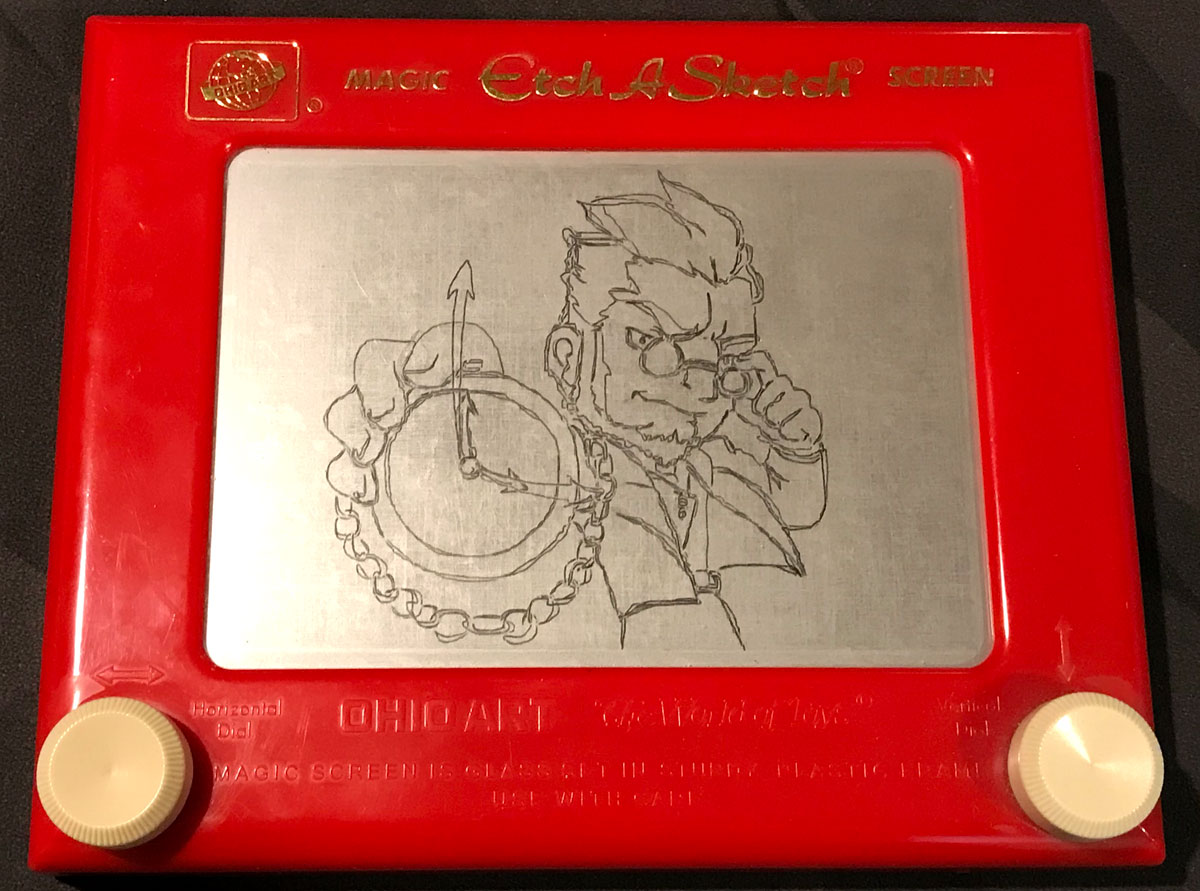
As with the other games featuring these characters, each character’s abilities are unique and give them a particular flavor to play. It’s fun seeing these personalities carry over from game to game, even though they’re implemented in different ways. Geiger the precise watchmaker (whom I drew on my Etch-a-Sketch, pictured above) manipulates time by dumping his deck into his discard pile, thus getting to those newly purchased cards more quickly, or by peeking at the top of his deck and rearranging the cards there. Lum the gambling panda lives on the edge with cards that pay off if his gem pile is high or if he can discard one card of each color from his hand. Jaina the phoenix archer is still playing with fire—she has cards that are powerful but also cause her to take wounds or pay more to buy cards. Even though there are only 3 cards in your deck that represent your character, it’s fun to see how they can affect the feel of the game.
I was trying to decide whether I like Puzzle Strike 2 more or less than the original version, and was having a hard time answering that. Despite the shared theme and some overlap in mechanics, they’re really just two different games. Puzzle Strike 2 may appeal more to those who like the added color-matching puzzle, as well as those who just prefer to shuffle actual cards. The original has the fun factor of just throwing your chips into the bag and shaking them up, but setup and takedown is a little more tedious because of all the individual stacks of chips.
If you enjoy deck-building games and you’re also a fan of puzzle-style video games, you should give Puzzle Strike 2 a look! For more information or to make a pledge, visit the Puzzle Strike 2 Kickstarter page!
Click here to see all our tabletop game reviews.
![]() To subscribe to GeekDad’s tabletop gaming coverage, please copy this link and add it to your RSS reader.
To subscribe to GeekDad’s tabletop gaming coverage, please copy this link and add it to your RSS reader.
Disclosure: GeekDad received a prototype of this game for review purposes.
Click through to read all of “Kickstarter Tabletop Alert: ‘Puzzle Strike 2’” at GeekDad.If you value content from GeekDad, please support us via Patreon or use this link to shop at Amazon. Thanks!



